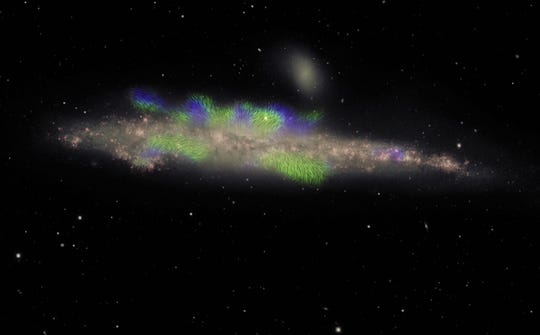NMSU astronomers contribute to discovery of giant magnetic ropes in galaxy’s halo – Las Cruces Sun-News
From Staff Reports, Las Cruces Sun-News Published 12:40 p.m. MT Dec. 7, 2019
CONNECTCOMMENTEMAILMORE
LAS CRUCES – A New Mexico State University astronomy professor and his former graduate students are part of an international team of astronomers whose work helped create an image of the “Whale Galaxy” (NGC 4631), made with the National Science Foundation’s Karl G. Jansky Very Large Array (VLA), that reveals hair-like filaments of the galaxy’s magnetic field protruding above and below the galaxy’s disk.
The spiral galaxy is seen edge-on, with its disk of stars shown in pink. The filaments, shown in green and blue, extend beyond the disk into the galaxy’s extended halo. Green indicates filaments with their magnetic field pointing roughly toward us and blue with the field pointing away. This phenomenon, with the field alternating in direction, has never before been seen in the halo of a galaxy.
“This is the first time that we have clearly detected what astronomers call large-scale, coherent, magnetic fields far in the halo of a spiral galaxy, with the field lines aligned in the same direction over distances of a thousand light-years. We even see a regular pattern of this organized field changing direction,” said Marita Krause, of the Max-Planck Institute for Radioastronomy in Bonn, Germany.
Rene Walterbos, NMSU astronomy professor emeritus and former NMSU graduate student Carlos Vargas, now a postdoctoral researcher at Arizona at University of Arizona, are part of the project called the Continuum HAlos in Nearby Galaxies – an EVLA Survey (CHANG-ES), led by Judith Irwin of Queen’s University in Ontario.
The image indicates a large-scale, coherent magnetic field that is generated by dynamo action within the galaxy and spirals far outward in the form of giant magnetic ropes perpendicular to the disk.
“We are a little bit like the blind men and the elephant, since each time we look at the galaxy in a different way we reach a different conclusion about its nature! However, we seem to have one of those rare occasions where a classical theory, about magnetic generators called dynamos, predicted the observations of NGC 4631 quite well. Our dynamo model produces spiraling magnetic fields in the halo that are a continuation of the normal spiral arms in the galaxy’s disc,” said Richard Henriksen, of Queen’s University.
The NMSU Team is contributing to the CHANG-ES project by determining the distribution of young massive stars in the galaxies, by combining optical imaging data from the Apache Point Observatory 3.5-meter telescope with infrared images from the NASA WISE mission. The Wide-field Infrared Survey Explorer is a NASA infrared wavelength astronomical space telescope launched in December 2009.
Never miss an innovation:Subscribe to the Las Cruces Sun-News today.
“For this particular galaxy, NGC 4631, the optical data shown were obtained by former graduate student Maria Patterson as part of another project with the Kitt Peak Observatory 4-meter Mayall telescope, which offered the large field of view necessary to image the entire galaxy. Patterson obtained her Ph.D. at NMSU in 2012,” Walterbos said. “The radio emission originates from cosmic ray electrons spiraling in magnetic fields. The electrons, moving at close to the speed of light, arise in violent supernova explosions, the end phases of massive stars.
“The spectacular magnetic field structures, seen in the VLA radio data in this image, highlight the complex interactions between stars, gas, cosmic rays and magnetic fields in this galaxy.”
The scientists are continuing their work to further refine their understanding of the galaxy’s full magnetic structure.
The radio image was made by combining data from multiple observations with the VLA’s giant dish antennas, arranged in different configurations to show both large structures and finer details within the galaxy. The naturally-emitted radio waves from the galaxy were analyzed to reveal the magnetic fields, including their directions.
The scientists said the techniques used to determine the direction of the magnetic field lines, illustrated by this image, now can be used on this and other galaxies to answer important questions about whether coherent magnetic fields are common in galactic halos and what their shapes are.
Building such a picture, they said, can answer important questions such as how galaxies acquire magnetic fields, and whether all such fields are produced by a dynamo effect. Can these galaxy halo fields illuminate the mysterious origin of the even larger intergalactic magnetic fields that have been observed?
NGC 4631, 25 million light-years from Earth in the constellation Canes Venatici, is about 80,000 light-years across, slightly smaller than our own Milky Way. It was discovered in 1787 by the British astronomer Sir William Herschel. This image also shows a companion, NGC 4627, a small elliptical galaxy, just above NGC 4631.
The National Radio Astronomy Observatory is a facility of the National Science Foundation, operated under cooperative agreement by Associated Universities, Inc.
Keep reading:
- Apache Point ranked No. 2 among U.S. college observatories
- New Mexico Space Grant at NMSU has storied legacy, looking to next 30 years
- Virgin Galactic CEO George Whitesides: Company marks ‘incredible’ year of milestones
CONNECTCOMMENTEMAILMORE
Read or Share this story: https://www.lcsun-news.com/story/news/local/community/2019/12/07/nmsu-astronomers-help-discover-giant-magnetic-ropes-galaxys-halo/4366220002/






